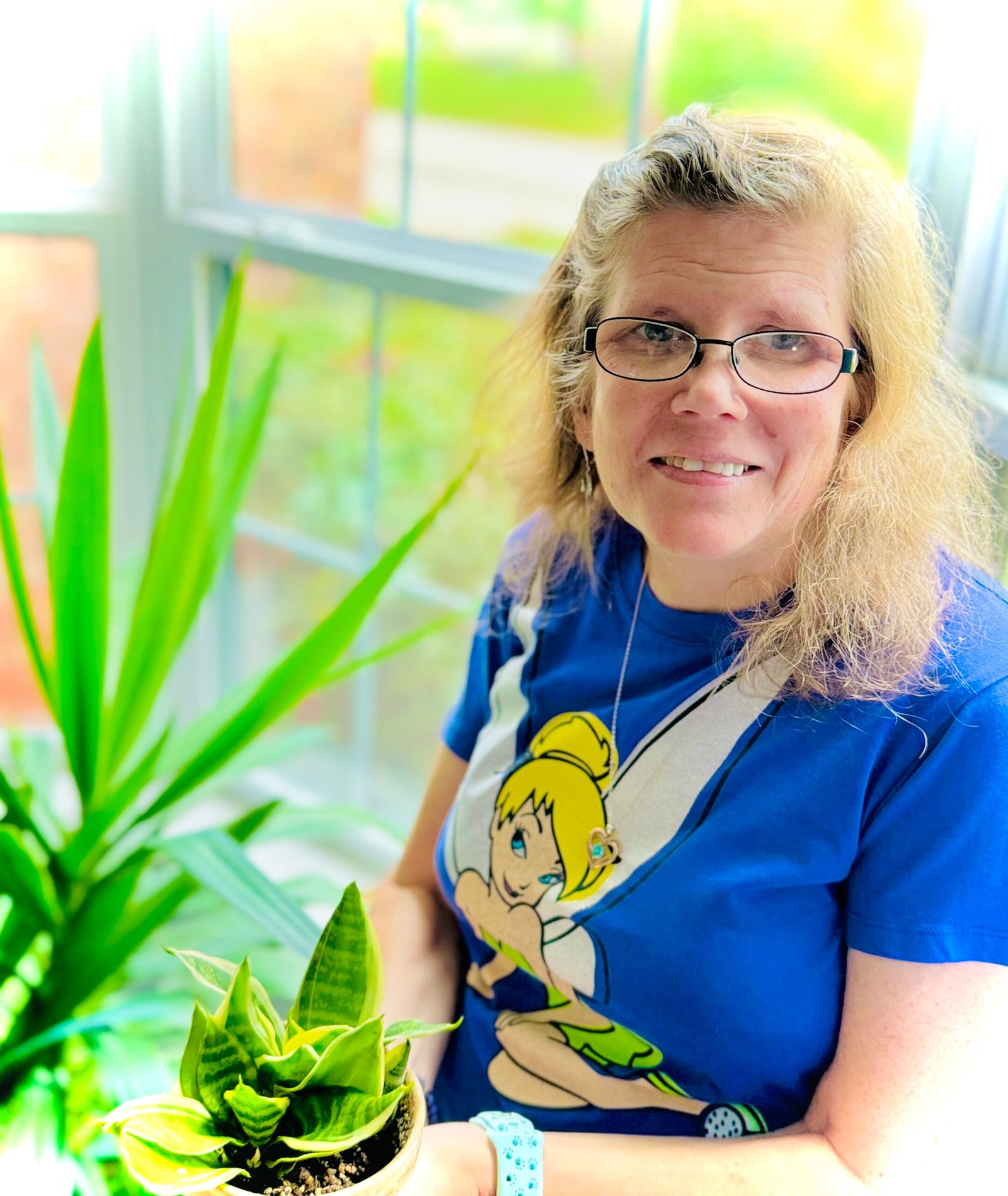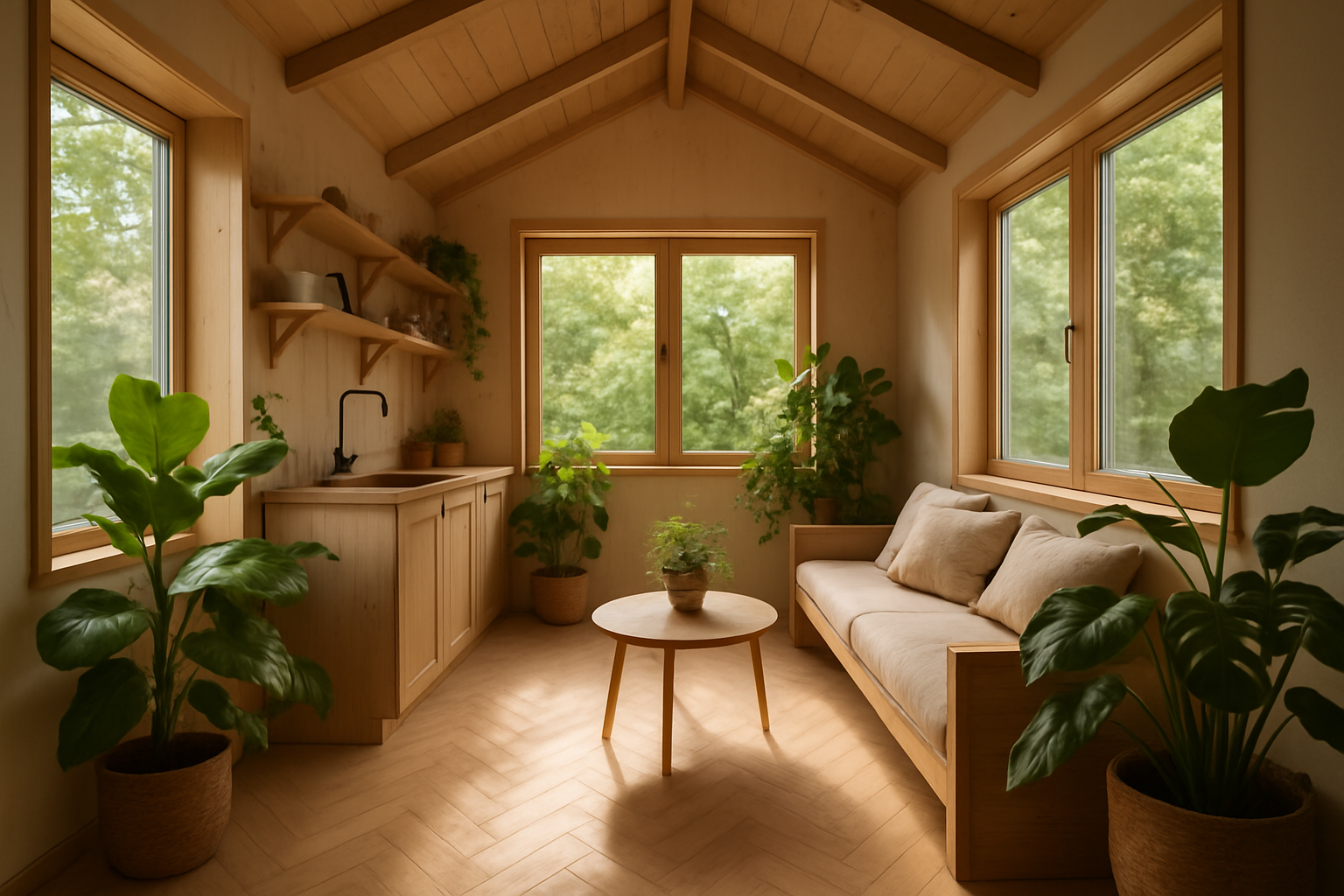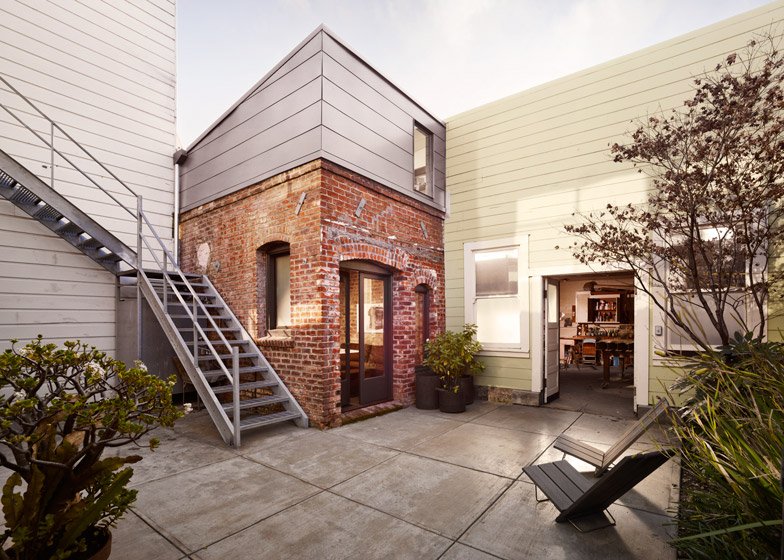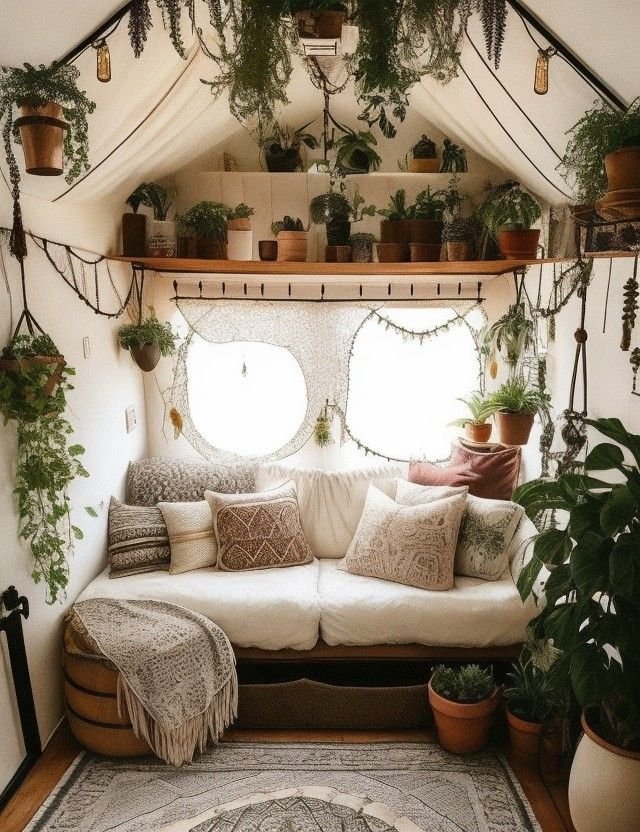In the ever-evolving world of tiny living, design is more than just aesthetics; it’s about maximizing every square inch with purpose and panache. As we step into 2025, tiny house interior design is witnessing a fascinating convergence of cutting-edge trends and timeless principles, all geared towards creating spaces that are not only visually appealing but also supremely functional and comfortable. Gone are the days when tiny homes were solely about sacrifice; today, they are epitomes of thoughtful design, sustainable living, and personalized sanctuaries.
As we explore Tiny House Interior Design Trends, it’s essential to consider how these elements can enhance both functionality and style.
Table of Contents
The latest Tiny House Interior Design Trends emphasize a balance between aesthetics and practicality, ensuring that every design choice contributes to a harmonious living space.
This comprehensive guide will explore the most influential tiny house interior design trends of 2025, offering insights into how these trends are shaping the future of compact living. From innovative space-saving solutions to the embrace of natural elements and smart technology, we’ll delve into how you can transform your tiny dwelling into a haven that perfectly balances style with unparalleled functionality. Whether you’re a seasoned tiny home dweller or just beginning your journey into the minimalist lifestyle, these trends will inspire you to create a space that truly reflects your personality and meets your every need.
Incorporating the latest Tiny House Interior Design Trends can lead to a more personalized and efficient living environment.
The Evolution of Tiny House Design: Beyond Minimalism
These Tiny House Interior Design Trends will continue to inspire a wave of new homeowners looking for unique solutions.
These Tiny House Interior Design Trends highlight the importance of bringing the outdoor elements into your home design.
For years, minimalism has been synonymous with tiny house living, and while its core tenets of decluttering and intentional living remain vital, the design landscape is expanding. In 2025, tiny house interiors are moving beyond stark simplicity to embrace a richer, more nuanced aesthetic. This evolution is driven by a desire for comfort, personalization, and a deeper connection to the environment. Designers are now focusing on creating warm, inviting spaces that feel expansive despite their compact footprint, utilizing clever tricks and innovative materials to achieve this.
Ultimately, the evolution of Tiny House Interior Design Trends points to a more sophisticated approach to compact living.
One of the most significant shifts is the move towards
The goal of these Tiny House Interior Design Trends is to create livable spaces that do not sacrifice style for function.
Implementing Tiny House Interior Design Trends will also help in maintaining a sustainable lifestyle.
biophilic design, which integrates natural elements into the indoor environment. This trend is particularly potent in tiny homes, where the connection to nature can enhance well-being and create a sense of openness. Think large windows that frame natural landscapes, indoor plants that purify the air and add a touch of greenery, and the use of natural materials like wood, stone, and bamboo. These elements not only bring the calming influence of the outdoors inside but also contribute to a healthier living environment.
Many homeowners are now prioritizing Tiny House Interior Design Trends that focus on energy efficiency.
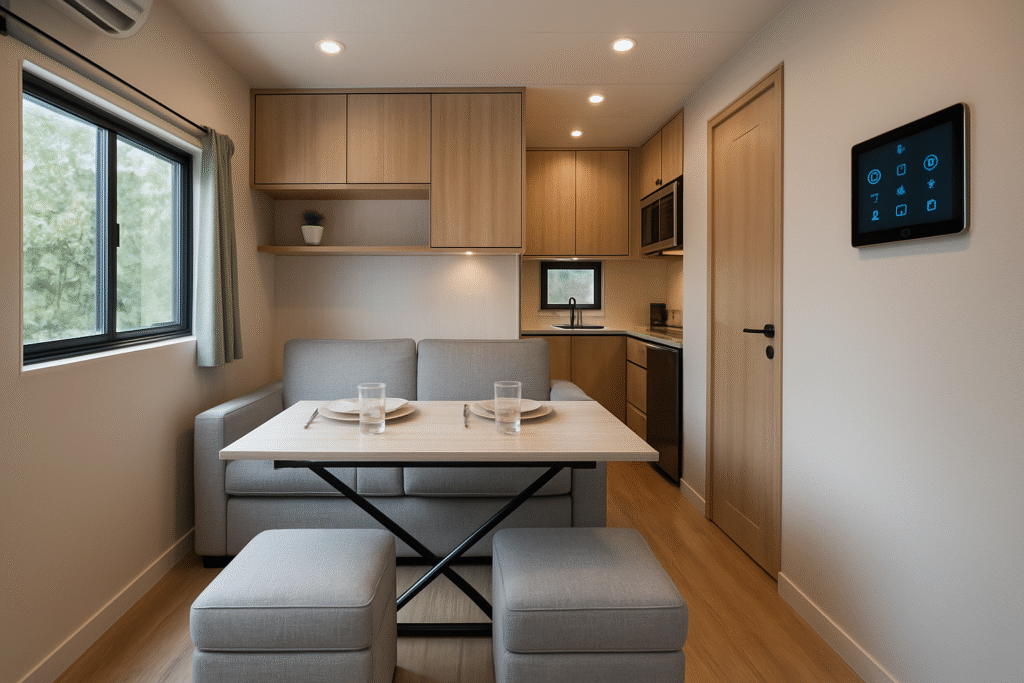
Another key aspect of this evolution is the increasing sophistication of multi-functional furniture. No longer are these pieces merely practical; they are now design statements. In 2025, we’re seeing innovative designs that seamlessly transform from one function to another, often with hidden compartments and clever mechanisms. Sofa beds that convert into dining tables, modular shelving units that can be reconfigured to serve different purposes, and beds that lift to reveal ample storage underneath are becoming standard.
These pieces are crucial for maximizing space in tiny homes, allowing residents to adapt their living areas to various activities throughout the day without compromising on style or comfort. The emphasis is on fluidity and adaptability, ensuring that every piece of furniture earns its place in the compact footprint of a tiny home.
Trend 1: Sustainable and Eco-Conscious Living
Sustainability is no longer a niche concept but a fundamental pillar of tiny house design in 2025. Homeowners are increasingly conscious of their environmental footprint, leading to a surge in demand for eco-friendly materials and energy-efficient solutions. This trend extends beyond the construction phase to the interior design choices, influencing everything from insulation to decor.
Reclaimed and Recycled Materials: The use of reclaimed wood, recycled metal, and upcycled furniture is gaining immense popularity. These materials not only reduce waste but also add character and a unique story to the tiny home. Barnwood accent walls, countertops made from recycled glass, and furniture crafted from salvaged materials are common sights. This approach aligns perfectly with the tiny house ethos of living lightly on the earth and embracing resourcefulness.
Soft lighting is one of the Tiny House Interior Design Trends that enhances the cozy atmosphere in small spaces.
Energy Efficiency and Smart Technology: Integrating smart home technology and energy-efficient appliances is another significant trend. From smart thermostats that optimize heating and cooling to energy-saving LED lighting and water-saving fixtures, technology is being harnessed to reduce utility consumption. Solar panels and rainwater harvesting systems are also becoming more prevalent, allowing tiny homes to be more self-sufficient and reduce their reliance on external grids. This focus on energy efficiency not only benefits the environment but also leads to significant long-term savings for homeowners.
Non-Toxic and Natural Finishes: There’s a growing awareness of indoor air quality, leading to a preference for non-toxic paints, low-VOC finishes, and natural textiles. Materials like organic cotton, wool, and linen are favored for their breathability and minimal environmental impact. This ensures a healthier living environment for residents, free from harmful chemicals often found in conventional building materials.
Trend 2: Warm Minimalism and Earthy Palettes
While minimalism remains a core principle, the trend in 2025 is towards a
warmer, more inviting version of minimalism, often referred to as “warm minimalism.” This approach combines the clean lines and uncluttered spaces of traditional minimalism with natural textures, soft lighting, and earthy color palettes to create a cozy and serene atmosphere. The goal is to make tiny homes feel like sanctuaries, not sterile boxes.
Utilizing vertical space is a key aspect of many Tiny House Interior Design Trends that maximize functionality.
Earthy Color Palettes: Expect to see a dominance of muted, earthy tones such as terracotta, sage green, dusty rose, warm grays, and various shades of beige and cream. These colors evoke a sense of calm and connection to nature, making small spaces feel more grounded and expansive. They also serve as a versatile backdrop for natural materials and textures, allowing them to shine.
Embracing these Tiny House Interior Design Trends will ultimately shape the future of sustainable living.
Natural Textures and Materials: The emphasis on natural materials extends to textiles and finishes. Think linen curtains, wool throws, jute rugs, and wooden furniture with visible grain. These textures add depth and visual interest without overwhelming the small space. Concrete, clay, and natural stone are also being incorporated for their tactile qualities and organic appeal, creating a sense of authenticity and craftsmanship.
Soft and Layered Lighting: Harsh, overhead lighting is out. In 2025, tiny homes will feature layered lighting schemes that create warmth and ambiance. This includes a combination of natural light (maximized through large windows and skylights), task lighting (under-cabinet lights, reading lamps), and accent lighting (LED strips, decorative pendants). Dimmers are essential for controlling the mood and adapting the lighting to different times of day and activities. The strategic placement of mirrors can also amplify natural light and make spaces feel larger.

Future trends in tiny house design will continue to evolve, making the Tiny House Interior Design Trends even more relevant.
Trend 3: Multi-Functional Spaces and Smart Layouts
The inherent challenge of tiny living is maximizing every square foot. In 2025, designers are taking multi-functionality to new heights, creating spaces that seamlessly adapt to various needs throughout the day. This trend is about intelligent design that anticipates and accommodates the diverse activities of tiny home residents.
Transformable Furniture: As mentioned earlier, transformable furniture is a cornerstone of this trend. Beyond the traditional sofa bed, we’re seeing more innovative solutions like dining tables that fold away into walls, beds that descend from the ceiling, and modular seating arrangements that can be reconfigured for dining, lounging, or working. These pieces are not just space-savers; they are integral to the dynamic nature of tiny living. For more ideas on maximizing space, check out our article on Clever Storage Solutions for Every Tiny Home.
Open-Concept Living with Defined Zones: While open-concept layouts remain popular for their spacious feel, there’s a growing trend towards subtly defining zones within these open spaces. This can be achieved through various design elements without the need for physical walls. For instance, a change in flooring material can delineate the kitchen from the living area, or a strategically placed rug can define a cozy reading nook. Half-walls, open shelving units, and even changes in ceiling height can also create visual separation without sacrificing the open feel. This allows for a sense of order and purpose within the compact footprint.
Vertical Space Utilization: Every inch of vertical space is being leveraged. Floor-to-ceiling shelving, lofted beds, and integrated storage within staircases are becoming standard. Walls are no longer just boundaries but opportunities for storage and display. Magnetic strips for knives in the kitchen, pegboards for tools, and wall-mounted desks that fold away are all examples of how vertical space is being optimized. This is crucial for keeping clutter at bay and ensuring that essential items are easily accessible without taking up valuable floor space.
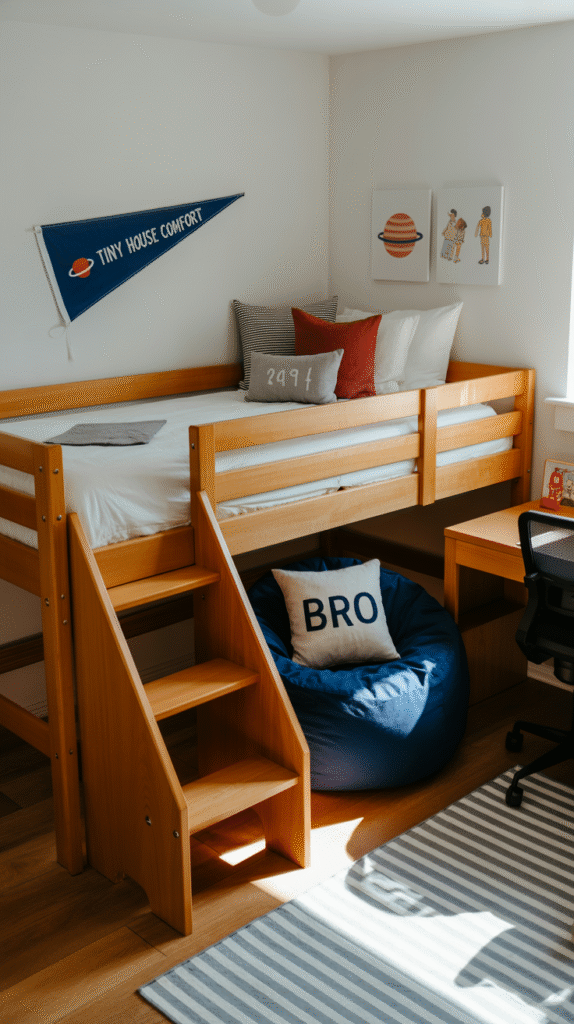
Trend 4: Personalization and Artisanal Touches
Expect to see more innovative solutions as Tiny House Interior Design Trends push the boundaries of creativity.
As we conclude, it’s clear that Tiny House Interior Design Trends are reshaping how we view compact living.
In a world of mass-produced goods, there’s a strong desire for uniqueness and authenticity. Tiny homes in 2025 are becoming canvases for personal expression, incorporating artisanal touches and bespoke elements that reflect the homeowner’s personality and values. This trend moves away from generic, showroom aesthetics towards spaces that feel lived-in, curated, and deeply personal.
Handcrafted and Local Goods: Supporting local artisans and incorporating handcrafted items is a significant part of this trend. This could include custom-made furniture, hand-thrown pottery, woven textiles, or unique artworks. These pieces add character and a sense of story to the tiny home, making it feel less like a manufactured dwelling and more like a cherished abode. They also contribute to a sustainable economy by reducing reliance on mass production and supporting local communities.
Curated Collections and Displays: Tiny homes are not about accumulating possessions, but about thoughtfully curating what you own. In 2025, homeowners are displaying their passions and interests through carefully selected collections. This might be a small collection of vintage cameras, a display of unique plants, or a wall dedicated to travel souvenirs. The key is intentionality – each item has a purpose or tells a story, contributing to the overall narrative of the home. Open shelving and wall-mounted display cases are popular for showcasing these cherished items without adding clutter.
The evolution of Tiny House Interior Design Trends signifies a shift towards more mindful living.
Stay tuned for how these Tiny House Interior Design Trends continue to evolve in the coming years.
Bold Accents and Feature Walls: While earthy palettes dominate, there’s room for bold accents that inject personality. This could be a vibrant piece of art, a colorful throw pillow, or even a single feature wall painted in a striking hue. These accents serve as focal points, adding visual interest and preventing the space from feeling monotonous. The key is to use them sparingly and strategically to avoid overwhelming the small interior.
Ultimately, the focus on Tiny House Interior Design Trends will enhance the living experience for many.
Trend 5: Smart Home Integration and Seamless Technology
Technology continues to evolve, and in 2025, smart home integration in tiny houses is becoming more seamless and intuitive. The goal is to enhance convenience, efficiency, and security without adding visual clutter. This trend is about making technology work for the tiny home dweller, simplifying daily routines and optimizing the living experience.
With the right approach to Tiny House Interior Design Trends, your home can be both a retreat and a reflection of your values.
Integrated Smart Systems: Beyond individual smart devices, the trend is towards fully integrated smart home systems that control lighting, climate, security, and entertainment from a central hub or smartphone app. Imagine waking up to automated blinds opening, the coffee maker starting, and your favorite music playing – all with a single command. These systems can also monitor energy consumption, helping tiny home owners stay within their sustainable goals.
As you navigate these Tiny House Interior Design Trends, consider how they align with your personal lifestyle.
By following the latest Tiny House Interior Design Trends, homeowners can enjoy a more fulfilling lifestyle.
Integrating these Tiny House Interior Design Trends will create spaces that are not only beautiful but also functional.
Hidden Technology: The aesthetic of tiny homes benefits from technology that is integrated discreetly. This means hidden charging stations, retractable screens for entertainment, and appliances that blend seamlessly into cabinetry. The focus is on functionality without visual intrusion, ensuring that the technology enhances the living experience without detracting from the design. For example, smart mirrors can display information or act as entertainment hubs when not in use, disappearing into the wall when off.
Voice-Activated Assistants: Voice-activated assistants are becoming increasingly common, allowing hands-free control of various smart home functions. This is particularly useful in tiny spaces where counter and surface areas are limited. From adjusting the thermostat to playing music or ordering groceries, voice commands offer a convenient and efficient way to interact with the home environment.
Trend 6: Adaptable and Flexible Spaces
The concept of a fixed-function room is becoming obsolete in tiny homes. In 2025, the emphasis is on creating adaptable and flexible spaces that can serve multiple purposes throughout the day. This trend is driven by the need to maximize utility in a limited footprint and cater to the diverse needs of modern tiny home residents.
Convertible Areas: Think of a living area that transforms into a workspace during the day and a dining area in the evening. This is achieved through clever furniture design and thoughtful planning. For instance, a coffee table might extend to become a dining table, or a wall-mounted desk could fold down when needed. The ability to reconfigure spaces on demand is crucial for efficient tiny living.
Adopting the latest Tiny House Interior Design Trends can result in homes that foster well-being and productivity.
Ultimately, understanding the Tiny House Interior Design Trends will empower you to create a space that reflects your values.
Portable and Movable Elements: Furniture and decor that can be easily moved or reconfigured are highly valued. Lightweight chairs, nesting tables, and movable partitions allow residents to adapt their space to different activities. This flexibility ensures that the tiny home can evolve with the changing needs of its occupants, providing a dynamic and responsive living environment.
Zoning with Lighting and Color: Beyond physical dividers, lighting and color are powerful tools for creating flexible zones. Different lighting schemes can define areas for work, relaxation, or dining, even within an open-concept layout. Similarly, subtle changes in wall color or the use of accent colors can visually separate areas without the need for physical barriers. This allows for a fluid transition between different functions, enhancing the overall versatility of the tiny home.
Trend 7: Health and Wellness Focus
The well-being of residents is a paramount concern in tiny house design for 2025. This trend encompasses elements that promote physical and mental health, creating a serene and rejuvenating living environment. From air quality to natural light, every aspect is considered to foster a sense of calm and vitality.
Improved Air Quality: With smaller spaces, indoor air quality becomes even more critical. The trend is towards incorporating air-purifying plants, using natural ventilation systems, and opting for materials that do not off-gas harmful chemicals. Advanced air filtration systems are also gaining popularity, ensuring that the air inside the tiny home is clean and healthy. This focus on air quality contributes to better respiratory health and overall well-being.
Natural Light Maximization: Access to natural light is essential for mental and physical health. Tiny homes in 2025 are designed to maximize natural light through large windows, skylights, and strategically placed mirrors. This not only reduces the need for artificial lighting but also connects residents to the outdoors, improving mood and regulating sleep patterns. The goal is to create bright, airy spaces that feel open and inviting.
Comfort and Ergonomics: Despite the limited space, comfort and ergonomics are not compromised. Furniture is chosen for its comfort and support, and layouts are designed to facilitate ease of movement. Adjustable desks, ergonomic seating, and comfortable sleeping arrangements are prioritized to ensure that residents can live and work comfortably within their tiny homes. The focus is on creating a supportive environment that promotes physical well-being.
Sound Dampening: In a small space, sound can easily travel. The trend is towards incorporating sound-dampening materials and design elements to create a more peaceful and private environment. This could include insulated walls, sound-absorbing panels, or even strategically placed textiles that help to muffle noise. The goal is to create a tranquil retreat where residents can relax and recharge without disturbances.
These Tiny House Interior Design Trends ensure a balance between comfort, sustainability, and visual appeal.
The tiny house interior design trends of 2025 reflect a growing desire for intentional living, sustainability, and personalized comfort. From the embrace of warm minimalism and natural materials to the integration of smart technology and adaptable spaces, these trends are transforming tiny homes into highly functional, aesthetically pleasing, and deeply personal sanctuaries.
The future of tiny living is not about sacrificing comfort or style, but about redefining what it means to live well in a smaller footprint. By thoughtfully incorporating these trends, tiny home dwellers can create spaces that not only meet their practical needs but also nourish their souls and connect them more deeply to their surroundings. As the tiny house movement continues to gain momentum, these design innovations will undoubtedly inspire a new generation of homeowners to embrace the beauty and efficiency of compact living. The emphasis on sustainability, health, and personalized design ensures that tiny homes will remain at the forefront of innovative and conscious living for years to come.
